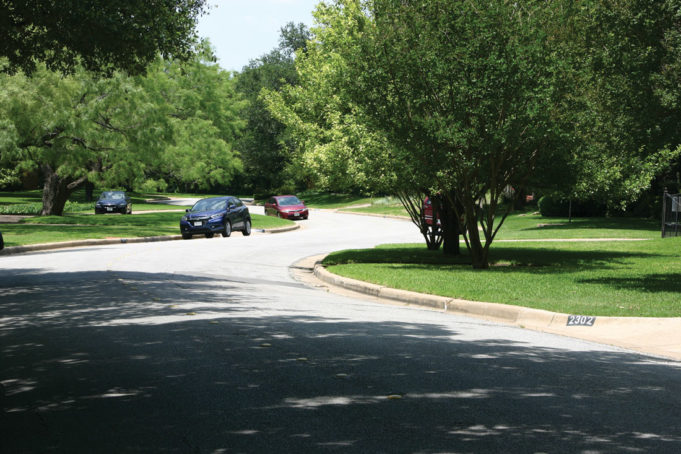NIMBY is a late 20th-century acronym for Not In My Backyard, which evolved into a real, official word that means local resistance to unwanted land uses.
But it is front yards that a small number of homeowners – “NIMFYS”? – want to save on Mistletoe Drive just west of Forest Park Boulevard not too far from TCU.
Fort Worth’s Transportation & Public Works Department is planning to build sidewalks on the south side of Mistletoe in front of nine houses that have been doing without a sidewalk for about 70 years. A spokesperson for eight of the homeowners said they don’t want or need the sidewalks. The spokesperson, speaking anonymously so as not to anger city officials or neighbors, said the homeowners worry that sidewalks will bring unwanted pedestrian traffic to an otherwise quiet street, eat away at driveway space on some properties, threaten the health of old trees in front yards, and reduce property values on houses that vary in market value between about $500,000 and $1 million.
“It is going to ruin the aesthetics and cause a lot of problems for everyone,” the homeowner said.
City Councilwoman Ann Zadeh, whose district includes the neighborhood, said sidewalks are needed to provide safe pedestrian travel, particularly on a street such as Mistletoe Drive, which winds like a snake and contains blind curves.
The Mistletoe Heights Neighborhood Association pushed for the sidewalk to create safe routes to schools in the area, Zadeh said.
“We had some money designated in the last bond to complete gaps where sidewalks ended and didn’t match up to other locations,” she said.
Most of the streets in Mistletoe Heights, a neighborhood with approximately 500 houses, already have sidewalks. The homeowner said the new sidewalk will be built about three feet from one of his large magnolia trees with shallow roots, some of which will have to be cut, which could possibly stunt or kill the tree.
Zadeh said city workers have surveyed the area and don’t believe any old growth trees will be harmed when building the sidewalks
The homeowner said plenty of sidewalks already exist in the neighborhood and considers tearing up nine beautiful front yards to put in sidewalks overkill. Of the nine properties that will be impacted, only one homeowner – Jeff Davis, who owns a local title company and was once married to former City Councilmember and state Senator Wendy Davis – said he wanted the sidewalk.
The neighborhood association meeting to vote on the sidewalks was held at Davis’s house and included about 10 percent of the neighborhood’s 500 homeowners in attendance, according to Davis.
Davis denied having any involvement in soliciting for sidewalks.
“That’s crazy,” he said. “I’m not pushing it.”
The meeting was held in his house because he has “a large living room,” he said.
Despite wanting sidewalks personally, Davis voted against them on his street as a show of respect and unity with his immediate neighbors, who don’t want them, he said.
Of the 50 people at the meeting, about 35 voted in favor of the sidewalks, Davis said.
Zadeh said the neighborhood association meets regularly, posts notices about its meetings, and doesn’t exclude homeowners from attending to share their feelings about issues. Sidewalks are part of city infrastructure needed for safe transportation, she said, like streets.
“If people protested having a sidewalk put in the city’s right of way in front of their homes, and we were to stop projects based on that, I don’t think we would be able to fill the [sidewalk] gaps across the city,” she said. “I didn’t think it was a good precedent to set. I just wanted to provide safe routes for kids to walk to school. I was supportive of Transportation & Public Works’ recommendations that that gap be filled.”
The anonymous homeowner said the only reason the transportation department recommended a sidewalk is that the neighborhood association asked for it, and the only reason the group asked for it is because Davis wanted it.
“This whole thing came about because Jeff Davis knew some bond money was available” and, unlike his neighbors, would like to have a sidewalk run through his front yard, the anonymous neighbor said.
Other streets in other neighborhoods can expect sidewalks in the future, Zadeh said.
City employees maintain about 700 miles worth of sidewalks, although some neighborhoods, such as Stop Six, have large gaps without sidewalks. In some neighborhoods, sidewalks are in disrepair. Shifting soil and the intrusion of roots from nearby trees can lead to sidewalk failures.
“We are looking to close gaps where they exist,” she said. “We don’t have the funding to close all of those gaps all at once. We put $10 million into the bond in 2014. We are doing some pay-as-you-go funding to provide better walking infrastructure. I would anticipate the 2018 bond would have additional funding for sidewalks as well. It is something the City Council overall is promoting, a more walk-able environment.”












